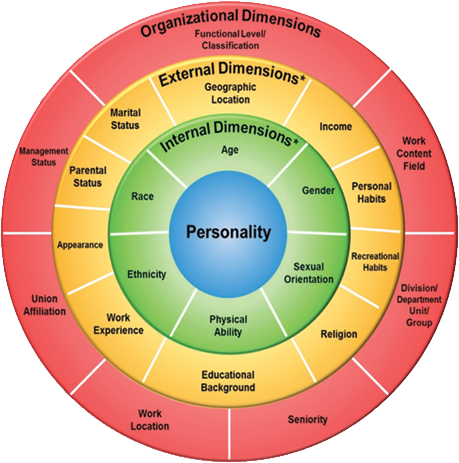Faezeh Sodagari, MD, Chair, ACR RFS Women & Diversity Advisory Group, PGY-5 Diagnostic Radiology Resident, Department of Radiology & Biomedical Imaging, Yale School of Medicine
Four Layers of Diversity: Implications for Radiology Trainees
When we think of diversity in the workplace, we often think about including individuals of different sex, race and sexual orientation. Although these dimensions of diversity are some of the most important aspects of an inclusive environment, many additional and less well-known dimensions to diversity can impact our experiences in a professional environment.
One of the goals of the ACR RFS Women and Diversity Advisory Group is to improve diversity in radiology training programs. To achieve this goal, we need to understand what diversity means and why it matters.
I recently came across a model that I found very useful in classifying different dimensions of diversity pertaining to individuals within an organization.
Lee Gardenswartz and Anita Rowe introduced the "four layers of diversity" or "wheel of diversity" model in their 2003 book, "Diverse Teams at Work: Capitalizing on the Power of Diversity,"1 which provides organizations guidance on how to build inclusive work environments and diversify groups while building relationships. This model describes four layers of attributes that create diversity and through which we process information:
- Personality — Encompasses the individual's values and beliefs and what they like or dislike. Shaped early in life, this attribute is impacted and affected by life’s circumstances.
- Internal dimensions — Qualities that we predominantly have no direct control over; these attributes are the first things we see in other people, about which we make assumptions and judgments. These factors create some of the deepest divisions among people, including issues with gender, race or sexual orientation.
- External dimensions — Aspects of lives that we can potentially control and may change over time. These qualities form the basis of decisions on careers, work styles and friendship circles and are often formed by environmental, cultural, and societal norms and experiences. Physical appearance, parental status, religion, income and educational background are examples of such factors.
- Organizational dimensions — Aspects of culture or classifications found in a workplace or organization that are often defined and influenced by leadership and culture. These dimensions often play a crucial role in providing opportunities for career growth and promotion. Examples include seniority, division or department affiliation, job classification or alignment with a union.
These factors2 shape both individuals and organizations in profound ways. Internal factors are the focus of most diversity initiatives given the historical lack of diversity in several settings. Long-term success of these diversity efforts should address and target all these dimensions.

As you review the "wheel of diversity", try to remember situations or experiences when you or someone else were excluded or felt unwelcome in your workplace, such as your training program, hospital, department or even volunteer activities:
- Have you or someone you know ever felt uneasy or excluded because they were a junior resident in a group of seniors?
- Have you ever witnessed a discussion about someone's appearance on their residency or fellowship job application?
- Can someone who is a caregiver to children or an older individual attend at least some of your social events?
- Can an atheist, Muslim, Jewish, Christian or Sikh express their beliefs without being frowned upon or feel threatened?
- Have you or someone else ever judged someone's ability in radiology because of their foreign accent or skin color?
- Does your department have PPE or lead aprons appropriate for plus size or petite individuals?
- Have you or your colleagues ever been threatened by a patient because of your race or religion?
- Are there any accommodations without fear of retaliation for those with disabilities or chronic illness, such as special equipment or flexible work hours?
- In any of these situations, is there a way to discuss what you experienced or felt with your program or someone else?
- Do you feel included? Can we do better?
- Gardenswartz, Lee and Rowe, Anita. Diverse Teams at Work: Capitalizing on the Power of Diversity, second edition. Society for Human Resource Management, 2003. Available at: https://www.gardenswartzrowe.com/store. Accessed Nov. 15, 2021.
- Internal and external dimensions adapted from: Loden, Marilyn and Rosener, Judy. Workforce America!: Managing Employee Diversity as a Vital Resource. Business One Irwin, 1991. Available at: https://www.gardenswartzrowe.com/why-g-r. Accessed Nov. 15, 2021.